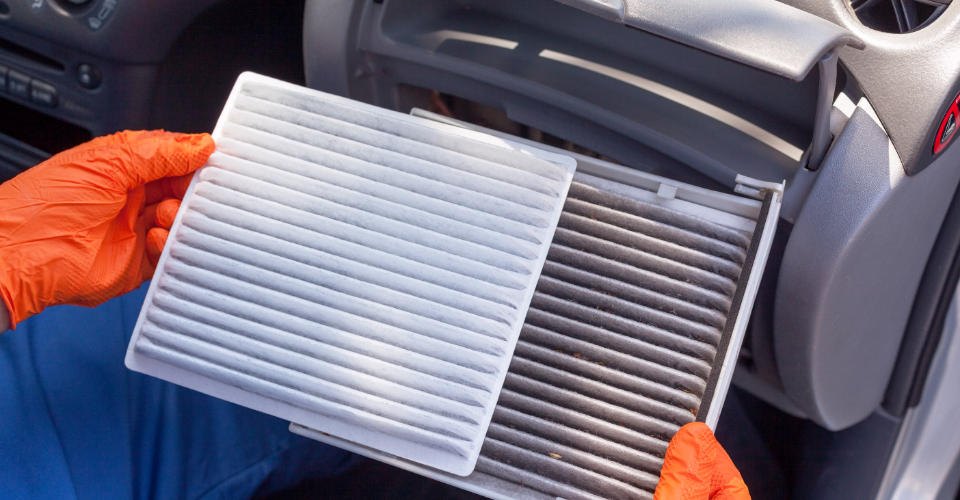You might not think much about the air inside your car until your vents start blowing out musty smells or your allergies kick in during a drive. That’s where your cabin air filter steps in. It’s a small, often overlooked component that works quietly in the background to keep the air you breathe clean and fresh.
Let’s break down what it is, why it matters, and when you should replace it.
What Exactly Is a Cabin Air Filter?
Think of the cabin air filter as your car’s version of a face mask filtering the air that comes through your air conditioning, heating, and ventilation system before it reaches your nose and lungs.
It traps things like:
- Dust and pollen
- Mold spores and bacteria
- Vehicle exhaust and smog
- Soot, smoke, and even road debris
If you have allergies, drive in dusty or polluted environments, or often get stuck in traffic, this filter is doing you a big favour silently improving your in-car air quality.
Why Should You Care?
A dirty or clogged cabin filter doesn’t just affect the air you breathe. It can also:
- Reduce airflow from your vents
- Make your HVAC system works harder, affecting fuel efficiency
- Cause your windshield to fog up slower, especially in winter
- Lead to musty or unpleasant odours inside the cabin
- Trigger allergy symptoms or headaches during long drives
If you’ve noticed weak airflow or weird smells when you turn on the A/C, it might be time to take a peek at your cabin filter.
When Should You Replace It?
Most car manufacturers recommend changing the cabin air filter every 20,000 to 24,000 kilometres or once a year, whichever comes first.
But here’s the truth: that’s just a general guideline.
You might need to replace it more often if you:
- Drive in high-traffic areas with heavy pollution
- Travel through dusty, sandy, or desert-like conditions
- Live near wildfire-prone zones or construction sites
- Park under trees that shed leaves, seeds, or pollen
- Smell something stale or notice reduced airflow from your vents
Not sure when it was last changed? You can usually access it yourself it’s often behind the glovebox and only takes a few minutes to check.
Not All Cabin Air Filters Are the Same
Here’s a quick breakdown of the types available:
Standard Filter
Basic and affordable. Traps dust and larger particles, but not great for odours or microscopic pollutants.
Activated Carbon or Baking Soda Filter
Better at removing odours, fumes, and gases ideal if you live in a city or frequently drive behind diesel trucks.
HEPA Filter
The premium option. These trap 99.97% of tiny particles down to 0.3 microns, including pollen, mould, smoke, and bacteria. Perfect for allergy sufferers or those with respiratory issues.
Tip: If a HEPA filter isn’t available for your car, go for the one that blocks the smallest particles and includes odour-control layers.
Try This: Use Recirculate Mode
Just drove through a dusty area or stuck in traffic fumes? Hit the Recirculate button (usually shown as a car with a circular arrow). This setting pulls air from inside the car instead of drawing in more from outside giving your filter a break and cleaning the cabin air more efficiently.
But remember to switch it back after a while. Recirculating air too long can make the cabin feel stuffy, especially if you’ve got passengers.
Final Thoughts: Breathe Easier on Every Drive
Replacing your cabin air filter is a simple and inexpensive fix that can dramatically improve your driving experience. You’ll enjoy:
- Cleaner, fresher air
- Less sneezing and congestion
- Stronger airflow
- A more efficient HVAC system
If you can’t remember the last time, it was changed or if you’re noticing dusty smells, foggy windows, or weak airflow it’s probably overdue.
Final Tip: Don’t Panic Call MotorHub
Not sure how to check or change your cabin air filter? No worries that’s what we’re here for. Whether it’s a quick filter swap or a full air conditioning checkup, MotorHub’s expert mobile mechanics can come to you and sort it out on the spot.
